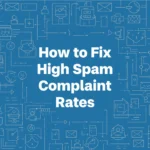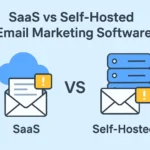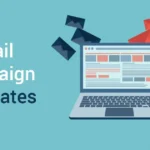The Complete Guide to Running High-Volume Campaigns

One of the most effective methods to increase the volume of communication with customers, sell an offer, and expand your business is conducting email campaigns involving large volumes of mail. However, it is not as easy as clicking on the button of sending thousands of emails, or even millions of emails. It must have a good infrastructure, dependable deliverability practices, warm-up procedures, list maintenance, and a clear idea of how mailbox providers empirically assess your reputation. An email marketing software that is self-hosted is a game changer here. It also lets you have more control of your sending environment, eliminates rigid SaaS constraints, and costs are reduced significantly once you begin to scale.
In contrast to the old-fashioned SaaS tools that also charge subscribers and limit cold mailing and mass outreach, with a self-hosted email marketing platform, you become its owner and decide on the IP addresses, domains, sending rates, bounces, authentication, and compliance configurations. This is suitable in agencies, SaaS products, high-volume marketers and businesses desiring to have their sending infrastructure. Nevertheless, in order to conduct large scale campaigns, it is important to know how to configure your server correctly, how to warm up sending domains, clean list, and create inbox-friendly content. This instruction manual takes you through each step by step.
Why High-Volume Senders Prefer Self-Hosted Email Marketing Applications?
The initial significant benefit of a self-hosted email marketing application is that it has no limit to the volume of outgoing emails. By using SaaS tools you are limited to the pricing levels, rate limits and acceptable use policies. Sending one hundred thousand emails may cost hundreds or thousands of dollars every month. Conversely, when using a self-hosted platform you can send as much as your server is able to take without worrying that you would be limited or even suspended. The infrastructure, the reputation and the freedom to send money is yours.
The other significant advantage is complete control of email. It is your duty to set up SPF, DKIM, DMARC, reverse DNS, IP warm-up, domain rotation, bounce processing, and suppression lists. Such control enables high-volume senders with the larger chances of controlling their placement of inboxes and the reputation of their senders. You are not exchanging IPs with thousands of other senders and rely on the quality of deliverability of a third-party tool. This is very important when sending tens of thousands of emails in a day.
Massive role is also played by cost savings. You need not pay a subscription fee; just invest in your server, SMTP it and software license (where necessary). This renders the model very scalable. The larger the volume sent, the larger the savings as compared to any SaaS platform. To put it in a nutshell, self-hosting emerges as the sole viable option in the case of a business that requires sending large packages on a regular basis.
Building a Strong Technical Foundation for High-Volume Sending
You should have a perfect technical set-up before issuing high volume campaigns. An email service that is self-hosted is very reliant on infrastructure. You must have a secure SMTP server/MTA like Postfix, PowerMTA, or Postal. Your server must be of sufficient sexual capacity to support huge queues and have more than one SMTP connection at a time. To support large-volume campaigns, a server with 8 or more CPUs, 16 to 32 GB of RAM and SSD storage is advisable as it is an intensive process.
At this point, it is necessary to establish a correct authentication. SPF, DKIM and DMARC need to be set and linked to your sending domain. Mailbox providers use these logs to decide how to grant you access to their systems as well as trust your emails. Reverse DNS should be similar to your sending IP, as your emails will automatically be rejected. To have an additional layer of brand trust in future, BIMI can be configured, but with a solid DMARC policy.
The future performance of your campaigns depends on your domain and ip warming strategy. You cannot purchase a new domain and lease a new IP and begin sending 50,000 emails on day one. This will result in spam placement or even blockage of an entire IP. Rather you will need to slowly build your territory over a series of weeks. Begin by sending out one or two hundred emails daily to your most active subscribers and gradually build up. This consistent action will assist in making mailbox providers identify your sending as authentic, regular, and devoid of spam.
Why Email List Quality Matters More at High Volume
The largest misconception that high volume senders have is that the server configuration is a guarantee of deliverability. In actual sense, the quality on your list is even more influential. When you have invalid, unresponsive and uninterested people in your email list, the rate of bounces and spam complaints will be very high and this will ruin your sender reputation more quickly than anything.
It is imperative to manage email lists with the right software and clean up the list on a regular basis. The high-volume email senders are required to verify the email lists, then they should import them into their own tool. Disposable emails, spam traps, invalid addresses, and toxic domains are some of the tools that can be eliminated with the help of such tools as MillionVerifier or ZeroBounce. This guarantees that in case of sending bulk email campaigns the bounce rate is kept at less than 2 percent which is mandated as far as good standing is concerned with email providers such as Gmail, Outlook, and Yahoo.
Segmentation is also necessary. Sending in large volumes does not imply bombarding everybody with one message. Sending content should be sent to particular groups with relevant content that enhances open rates and reduces the spam. As your levels of engagement go up, mailbox providers automatically give you a higher reputation score. This comes in particularly when you want to keep high inbox placements and increase volume.
How Email Content Affects Deliverability at Scale
Spam can still be placed even with a clean list and the use of a perfect authentication. The campaigns of volume should be designed so that they will not be considered spamming patterns. Excessive use of sales-heavy or capital letters, overwhelming use of graphics including large size graphics, overly promotional subject lines and overloaded links can damage your deliverability.
Should always write your emails in the conversational style and should always have value-driven messages and the text to image ratio should be healthy. A plain design works well compared to a richly-designed template when sending at volume particularly when reaching out on a cold, or transactional email. Also, it is important to always have a professional branded email address and never use a free Gmail or Yahoo email address as mailbox providers automatically look down upon personalized sender domains when posing bulk mail.
An unsubscribe link must be undertaken clearly, not just as a requirement, but also as a way of reducing spam complaints. Not having an unsubscribe button readily available makes the user mark your email as spam and this severely harms you domain reputation. Even the 0.1 per cent. complaint rate, at scale, can influence inbox placement.
How Throttling Protects Your Sender Reputation
The principle of high-volume sending should never be implemented in a huge push. Rather, you can use your system to slow down the emails going out in the long run. Self-hosted email marketing software normally has SMTP throttling rules which will enable you to manage how many email mails you can send per minute to each email provider. Gmail, Outlook, and Yahoo are characterized by varied levels of tolerance and excessively high rates will result in rate limits or one-time blocks.
Throttling causes your sending pattern to look natural. It helps in guarding your IP against a reputation collapse like a flash, as well as providing the mailbox providers the time to handle the incoming messages. A campaign that gets throttled has a better placement in the inbox in the long term.
Monitoring Your Deliverability and Reputation
An effective high volume sender is one that monitors the performance at all times. Even such small problems as an unforeseen increase in the number of bounces or poor open rate could reflect the problems with the reputation. A visit to Google Postmaster Tools, Microsoft SNDS and inbox placement testers will keep you on track of any obstacles that deliverability might introduce to you.
Monitoring your spam rate, bounce rate and engagement would make sure that you can turn your strategy around before it goes really wrong. When there is a loss of reputation, it is a good exercise to cut volume and only send mails to subscribers most receptive to your service so as to gain reputation again.
Scaling High-Volume Sending Gradually and Safely
As your domain is now warm and your sender reputation is steady, it is possible to start scaling. Sending at a high volume is always better done in stages. The initial number is 10000 emails a day, and then it can be increased to 20,000, 30,000 and further to more than 50,000-100,000 or above, based on what kind of infrastructure you have. In the case of extreme volumes, apply domains, IPs/SMTP rotation, and to evenly distribute load and to reduce risk.
Gradual growth cushions your reputation. Mailbox providers view you as a trusted sender when they notice that the pattern of growth is natural. When spikes are sudden that is recognized as possible spam behaviour and may flag your domain.
Final Thoughts
One of the most effective and the most cost-efficient methods to scale up your outreach is to run high-volume email campaigns with a self hosted email marketing software like Relayzo. You have complete control of your deliverability, infrastructure, and data and the limit that traditional SaaS tools set is removed. But there is responsibility with immense control. The way you set up, your list, your content and your habits of sending determine your success.
With proper technical base, careful list hygiene, proper warming of your IPs, close deliverability monitoring, and gradual scaling, one can always send a considerable amount of mail and produce an excellent inbox placement.
Recent Posts
-
 How Self-Hosted Email Marketing Helps You Cut Monthly SaaS Costs
How Self-Hosted Email Marketing Helps You Cut Monthly SaaS Costs -
 How Self-Hosted Email Marketing Improves Privacy and Data Ownership
How Self-Hosted Email Marketing Improves Privacy and Data Ownership -
 The Complete Guide to Running High-Volume Campaigns on a Self-Hosted Email Marketing Software
The Complete Guide to Running High-Volume Campaigns on a Self-Hosted Email Marketing Software -
 How to Fix High Spam Complaint Rates
How to Fix High Spam Complaint Rates -
 How to Use AI to Write Personalized Cold Emails
How to Use AI to Write Personalized Cold Emails -
 Top 10 Features You Didn’t Know Relayzo Has
Top 10 Features You Didn’t Know Relayzo Has -
 SaaS vs Self-Hosted Email Marketing Software: A Deep Dive
SaaS vs Self-Hosted Email Marketing Software: A Deep Dive -
 Why Your Bulk Emails Bounce and How to Stop It
Why Your Bulk Emails Bounce and How to Stop It -
 Unlocking the Advantages of Self-Hosted Email Marketing Software
Unlocking the Advantages of Self-Hosted Email Marketing Software -
 How Many Cold Emails Should You Send Per Day?
How Many Cold Emails Should You Send Per Day? -
 Top 10 Email Campaign Templates That Convert in 2025
Top 10 Email Campaign Templates That Convert in 2025 -
 Ultimate Checklist Before Sending Your First Massive Email Campaign
Ultimate Checklist Before Sending Your First Massive Email Campaign -
 Boost Your Campaign ROI with AI-Powered Email Marketing Software
Boost Your Campaign ROI with AI-Powered Email Marketing Software -
 Why I Switched to Self-Hosted Email Marketing with Relayzo: More Privacy, Less Cost
Why I Switched to Self-Hosted Email Marketing with Relayzo: More Privacy, Less Cost -
 Which Email Management Software is Best for Your Emails?
Which Email Management Software is Best for Your Emails? -
 Why AI Makes Bulk Email Marketing More Effective Than Ever?
Why AI Makes Bulk Email Marketing More Effective Than Ever? -
 Increase Conversions With Personalized Email Recommendations
Increase Conversions With Personalized Email Recommendations -
 What No One Tells You About Bulk Email Marketing (But You Should Know)
What No One Tells You About Bulk Email Marketing (But You Should Know) -
 What Is the Best Email Marketing Software for Startups?
What Is the Best Email Marketing Software for Startups? -
 Increase Customer Loyalty Through Strategic Email Marketing
Increase Customer Loyalty Through Strategic Email Marketing
